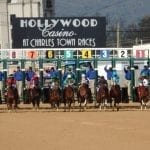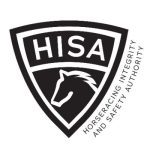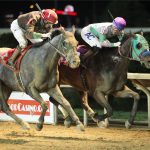Maryland horsemen, breeders propose nonprofit racing model
A week after representatives of 1/ST Racing, the parent company of the Maryland Jockey Club, called for a future with fewer racing days and heftier purses, representatives of the state’s horsemen and breeders outlined their own vision of the future – one that may not include the current track operator at all.
The Maryland Thoroughbred Horsemen’s Association and Maryland Horse Breeders Association made companion presentations to the state-created Maryland Thoroughbred Racetrack Operating Authority Friday afternoon. While the presentations on the one hand stood alone on their own merits, it was also clear they were a kind of counterpoint to last week’s 1/ST Racing offering.
“We respectfully disagree with the vision that was laid out here last week,” MTHA executive director David Richardson told the Authority in his opening remarks.
The presentations were a part of the Authority’s fact-finding work. Created by the General Assembly in the most recent legislative session, the Authority’s immediate task is to deliver by December 1 a report recommending, among other things, an operating model for Maryland racing in the years to come.
Richardson; MTHA president Tim Keefe, a Laurel-based trainer; and MTHA general counsel Alan Foreman – who also is a member of the Authority – sketched a portrait of an industry beset by fierce competition for the gambling dollar, saddled with substandard facilities, and hampered by a track operator they described as less than “fully engaged” and “not a good operator for Maryland.”
Yet at the same time, they, along with Maryland Horse Breeders Association executive director Cricket Goodall and president Kent Murray, described the Thoroughbred industry as a vital economic contributor to the state and an important participant in efforts to preserve open space and protect the Chesapeake Bay.
“In the horse industry, there’s 28,000 Maryland jobs,” Richardson pointed out. “The horse industry generates 80-plus million dollars of tax revenue… And we have over a $2.1 billion annual economic impact in the state of Maryland.”
We must “create an economic environment conducive to maintaining farms for breeding and raising horses, thereby serving the state of Maryland and preserving open spaces and the integrity of the Chesapeake Bay,” Goodall said, adding, “Pasture is the second-best filter for the bay, after forests.”
That warrants, they argued, the state’s continued involvement in racing, including managing this effort, assisting the industry in identifying and tapping new revenue sources to bolster purses and the state-bred fund, and perhaps going even farther than that.
At last week’s meeting, 1/ST executives Craig Fravel and Kevin Gilmore pointed to the sea of red ink in which the company is swimming. The solution, they said, was a dramatically shortened racing calendar – perhaps 80-90 days of live racing versus the 175 or so that have been the norm in Maryland in recent years – substantially increased purses, a share of video lottery terminal (VLT) revenue directed to the track operator, and a rebuilt “iconic” Pimlico.
CHECK OUT THE LATEST OFF TO THE RACES RADIO!
About the only element of that vision with which the horsemen and breeders did agree – in fact, in the very same wording – was the need for an “iconic” Pimlico. Otherwise, they suggested, the 1/ST Racing approach would be more of a death knell for Maryland racing than a plan for rebirth.
Take the proposal on dates, for example.
“We realize we’re gonna have to contract some dates,” Keefe allowed. “I guess the question is, what can you contract to if you have to contract and still have a year-round product? Without putting a number in concrete, and you can throw out a number, maybe it’s 140 days, maybe it’s 130. Maybe it’s 140. But you certainly can’t go much less than that.”
When the so-called 10-year deal was finalized 11 years ago, the horsemen at that time believed 146 days was their minimum. But years of declining foal crops nationally and stagnant or declining wagering are putting the squeeze on racing schedules everywhere.
Since the lion’s share of purse revenue comes not from parimutuel wagering but from the industry’s share of VLT, the 1/ST executives pointed out that gross annual purses in Maryland would remain substantially similar with fewer days, and per-race purses would grow. That could attract better horses and, in theory, higher wagering.
Not so fast, the horsemen’s advocates said. For one thing, given how infrequently horses do race, the horsemen prefer more opportunities at lower purse levels to fewer opportunities at higher. For another…
“You’ve got to know your sweet spot. We’re not a top-tier racing state anymore,” Foreman said. “There was a time when Maryland was; I think we’re in tier two now. Tier two tracks are absolutely critical to the foundation of racing not only in Maryland but throughout the country. You have to preserve those because they are the foundation. You cannot move this sport to just the elites or it will collapse. If you raise your purses too high, you’re going to invite the big outfits from out-of-state to come in and take those opportunities away from your own horsemen.”
As for more money heading to the track operator, the horsemen’s reps were decidedly cool, pointing out that they had provided more than $90 million in subsidies in the last 11 years.
“Additional unprecedented subsidies from the racing and breeding communities would further degrade Maryland purses [and] shrink Maryland’s breeding program,” Richardson said.
Yet while the 1/ST proposal called for significant changes to the racing landscape in Maryland, it left intact its basic contours. Specifically, the company envisioned a private operator continuing to run the racetracks, as has long been the norm here and is typical in the industry.
That, suggested the horsemen, may be the area most in need of change. With horsemen and breeders In search of what Richardson called “financial stability… and fully engaged local management, which we don’t believe we have,” now is the time to consider alternative approaches, they said.
A slide put up by the horsemen during their presentation suggested the creation of a nonprofit entity to serve as the racing licensee operating racing in the state under lease agreements with the Operating Authority, which would own the facilities. The arrangement is somewhat similar to that at Del Mar, where the state of California owns the fairgrounds, which are leased to the Del Mar Thoroughbred Club to conduct its live race meets.
“Why not look at a not-for-profit model for Maryland racing?” Foreman asked the Authority. “We suggested the idea of a Racetrack Operating Authority, which is what we have now. And then that would flow down to the not-for-profit entity that can operate our tracks with innovative management, good management, no subsidies, and is dedicated to Maryland racing… But that’s the model, and that’s the one that we think needs to be carefully studied as an alternative to private operation.”
Of course, how to get there from here, what it might cost – and how the current private operator might react – remain thorny questions without current clear answers. But, Authority chairman Greg Cross suggested, those are problems for a different day. For now, the Authority is engaging with the stakeholders to learn how they see the future.
“This is ‘blank sheet of paper’ time,” he said. “We are here to get it right.”
LATEST NEWS















It seems like the previous owner’s and current owner’s of our
race tracks are only in it for then self’s. Get rid of them,
It is a private for profit company who else should they be in it for ?
28,000 jobs in racing, Maryland has 2.56 million jobs in the state, yet we are giving welfare payments in the form of slot subsidies to a dying industry and they tout 28k jobs, a touch more than 1 percent of the jobs in the state. As predicted they went back to the green space argument again.